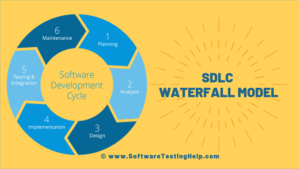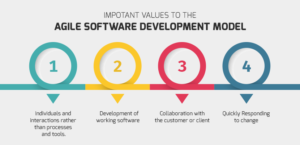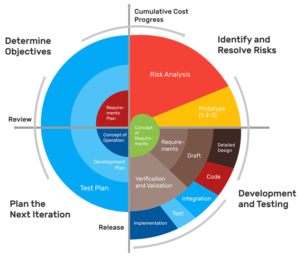These 12 Custom Software Methodologies Will Help Scale Your Business
By: Hardik Shah

Custom software development methodologies play a crucial role in developing software. The main purpose of these methods is to provide seamless software development as per project requirements. In this article, we’ll discuss some of the vital software development methodologies that business owners can apply to scale their businesses.
Methodology #1: Waterfall Model
The waterfall model is a process in which software is developed in broad stages. In actuality, it is a breakdown of project activities into linear sequential phases, where each step depends on the deliverables of the previous one. The waterfall model uses an approach that embraces five stages of SDLC, which are: 1) Client requirement gathering, 2) Design Sampling 3) Implementation 4) Testing, and 5) Maintenance.
The waterfall model is originally generated in the construction and manufacturing industries. This model is known as the heavyweight methodology as the processes are long and are quite inflexible. In this model, you can end up fully-functional software that meets every requirement of customers.
This model consists of a few essential benefits, let’s have a look:
- It’s simple, easy to understand, and can be implemented for projects of all sizes.
- Testing is an integral part of this model and offers a clear and concrete approach.
- Documentation for every stage is maintained by developers for making easier to map trails.
- This model ensures that the processes are completed in stages, and this is a time-saving factor.
- This methodology is easy to manage due to its rigidity. Each phase has specific deliverables and individual review processes.
- The waterfall model works more effectively in smaller projects where requirements are very understood.
Methodology #2: Agile Software Development Model
This approach, agile software development model, is used to design a disciplined software management process. It allows some frequent alternation in the development project. One of the most widely used software development methodologies is agile. This process includes design, implementation, testing, and release into ‘sprints’, typically two-week cycles.
The best part of this model is that it comes with full flexibility and helps in the reduction of risks as the custom software is separated into tiny bits of iterations. Fastest feedback and quick resolution are the best advantages that the method offers. Since it is a transparent software development model, it helps clients keep a tab on the progress of the project. This model is not recommended for small-time projects and requires the finesse and experience of skilled professionals who already have good exposure in this methodology.
Methodology #3: Prototype Methodology
This software development methodology is all about building, testing, and then reworking when needed until an acceptable prototype is achieved. It also creates a base to produce the final system. This methodology works best in scenarios where the project’s requirements are not known. It is an iterative, trial, and error method between the developer and client.
Here’re some advantages of Prototype Model:
- When a prototype shows to the clients, they will get a clear understanding and complete feel of the functionality of the software.
- The prototype model significantly lessens the risk of failure, as potential hazards can be identified in early stages, and moderation steps can be taken quickly.
- This model helps in requirement gathering and requirement analysis when there is a lack of required documents.
- The communication between the development team and clients makes a seamless and conducive environment during the project.
Methodology #4: Big Bang Model Methodology
This methodology is for simple projects where clients are unaware of the requirements, and how the project has to take shape. It possesses no rigid formal protocols, and is still uncomplicated. It also does not require pre-hand planning.
It focuses on all the possible resources in software development and coding, with minimal or no planning. The requirements are understood and implemented at the moment of arrival. It’s ideal for small projects with one or two developers working together. It’s also useful for academic or practice projects. Big Bang model methodology also works well for the products where requirements are not well understood, and final release date is not given.
Methodology #5: Rapid Application Development
As its name implies, this methodology aims at completing the project at a fast pace. It includes a combination of both agile and prototypes to create more rapid iterations and designs. This way, the process of software development develops faster. Stage wise testing ensures that the project completes well on time.
Methodology #6: Scrum Development
This methodology can be applied to nearly every kind of project. This process is used for speedy development projects, which involves rapid changes or highly emergent requirements. Scrum development method divides the workings of a project in smaller modules. Each module is taken forward with a unique strategy. It usually begins with a brief planning, meeting, and final review. This method is widely used for speedy development of software that includes a series of interactions to develop required software.
Here’re a few benefits of scrum development methodology:
- Decision-making is entirely in the hands of team members.
- It is a lightly-controlled method which totally emphasizes on frequent updates of progress. Thus, the steps of project development are visible in this method.
- It makes it easy to measure individual productivity due to meetings on a daily basis. This leads to an improvement in the productivity of each of the team members.
Methodology #7: Spiral Model
A sophisticated methodology, spiral model, focuses on early identification and reduction of project risks. In this method, developers start on a small scale and explore the risks involved in the project. The success of this methodology largely depends on the reliable, attentive, and knowledgeable management project. Since it embraces systematic processes, the development procedure is disciplined and linear. However, the time frame and budget might go extended, as only complicated projects can be executed successfully with this model. Check out some advantages of spiral model methodology:
- This model is ideal for large-size and critical projects.
- It’s also best-suited for high-risk projects, where business’s requirements may differ constantly.
- In this model, additional functionality can be added later.
Methodology #8: Dynamic Systems Development Model
This methodology is originally based on the Rapid Application Development (RAD) Model. It is an iterative and incremental approach, which emphasizes continuous user involvement. The main objective of this model is to deliver software systems on time within the budget. This model works on a rigid-time frame and has been formed on the premise that the developers of the custom software have to get continuous feedback leading to maximum functionality.
Dynamic Systems Development Model uses the Agile software development method because it breaks down the project into iterations. Every bit of process is taken forward with a set of unique methodologies and approaches. It is an expensive method and best-suited for lengthy projects where the frame is larger.
Methodology #9: Extreme Programming
Extreme Programming or XP methodology, is known as an agile software engineering method. It is mainly used for developing software in an unstable environment. This model provides greater flexibility within the modeling process. The main objective of this model is to lower the cost of software requirements. It is also common in this model that the cost of changing needs can be very high on the later stage. Check out some advantages of the Extreme Programming methodology:
- This model emphasizes customer involvement.
- It helps to establish rational plans and schedules to get the developers personally committed to their schedules that is a big advantage.
- This model is consistent with the most modern development methods; therefore, developers can produce quality software.
Methodology #10: Lean Software Development
The lean software development methodology is all about the creation of easily changeable software. This model is more strategically focused competitively than other types of agile methods. The main goal of lean software development method is to develop software in one-third of the time, with a minimal budget and less required workflow. With this methodology, you can get the following benefits:
- The early elimination of the overall efficiency of the development process helps to accelerate the process of entire software development, which inevitably reduces the cost of the project.
- It empowers the development team in developing the decision making ability to the team. Hence, this will add more motivation among team members.
- It allows developers to deliver the product early, which is one of the greatest advantages. It’s also safe to say that the development team can provide functionality in a shorter period of time.
Methodology #11: Feature-Driven Development
This method of custom software development is intended for large teams working together on a project using object-oriented technology. It is an excellent choice for those organizations that are switching from a phase-based approach to an iterative approach. Here’re a few advantages of feature-driven development methodology:
- It helps to move large size projects and acquire repeatable success.
- This model is built on the software development industry, therefore, it helps easy development and industry-recognized best practices.
- It also helps to work in a shorter period of time as well as an easier manner.
Methodology #12: Rational Unified Process
This methodology is shortly known as a RUP, which is a modern software development process. It divides the development process into four phases: business modeling, analysis and design, implementation, testing, and deployment. This is an object-oriented and web-enabled program development method. This model also enables developers by providing them guidelines, templates, and examples for all aspects and stages of software development.
Conclusion
The software development methodologies, as mentioned above, can be used in various software development. Undeniably, all methods work well in specific projects depending upon the type of project. Before selecting any of these methodologies, all you need to understand the needs of your project deeply. For outstanding results, business owners should consult a professional software development company near your region.
4008 Views
















